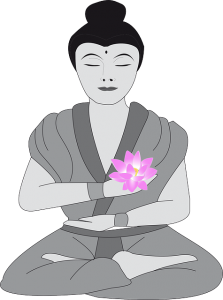 Most forms of meditation, by definition, are pretty boring. If a meditation technique was entertaining or exciting, it wouldn’t be meditation! Typically, in meditation you notice when your mind is wandering and then shift your awareness back to some simple meditative object like your breathing, or sound, or a repeated phrase. This is what triggers your body’s relaxation response as opposed to it’s stress response (which gets triggered a great deal in daily life).
Most forms of meditation, by definition, are pretty boring. If a meditation technique was entertaining or exciting, it wouldn’t be meditation! Typically, in meditation you notice when your mind is wandering and then shift your awareness back to some simple meditative object like your breathing, or sound, or a repeated phrase. This is what triggers your body’s relaxation response as opposed to it’s stress response (which gets triggered a great deal in daily life).
At the same time, meditation ideally involves great energy and focus. In my Soto Zen tradition we engage in “just sitting” meditation – when we’re doing it perfectly, we’re really just sitting there – and yet Zen masters encourage us to sit as if “putting out a fire on our heads.” How do you bring that kind of urgency and energy to your meditation when the practice itself involves setting aside your usual striving, thinking, and self-concern?
Below I share 10 methods I have used to enliven and vitalize my meditation. Potentially, each one can give you a way to tap into your deepest aspirations, and give you a focus for your effort – but without further agitating your mind:
1) Imagine You Will Die Today. Imagine that at some point later today your life ends. Don’t get stuck on the details of how that happens, although a car accident is a pretty appropriate thing to imagine. As you contemplate the shock of your approaching demise, allow your perspective to radically change. All of the things you are looking forward are never going to happen. You are used to thinking you have an untold number of days and years ahead of you, so this particular moment isn’t worth your attention, but this is it. Do you want to spend this time dozing, day-dreaming, or slumped in dullness? Or do you want to be as alert, present, and appreciative as you can be? Whenever your meditation goes slack, recall that this is your last meditation session ever.
2) Become Absolutely Silent and Still. As long as you are blabbing internally, you are cut off from what is happening around you right now. As long as you cherish your ideas and opinions, you experience everything through a filter. As long as you are agitated with your own agenda, you create ripples of causation in your life that obscure the subtle beauty of simply existing. Can you just listen? Can you open yourself up to the reality of the universe just as it is? What if life has something to tell you? The good thing about this approach is that you can always become more silent, still, and receptive.
3) Be without Words. This is a version of “Become Absolutely Silent and Still,” but it’s particularly effective for those of us very attached to verbal descriptions of our experience. Dare to let go of trying to control, define, or capture your experience by describing it. Experience with the body, or the heart, or intuition – anything except the discriminating mind and its verbiage. When you notice words in your mind, aspire to contact your life directly, without the crutch of verbal description – and for a moment, sink into wordlessness.
4) Let This Be Enough. Appreciate your life just as it is, right now, instead of seeing this moment only as a means to get somewhere else. Tell yourself you don’t need to do anything in order to come home to yourself. Let go of your compulsion to do, improve, achieve, gain, change, or justify your existence. Give yourself permission just to be – to take a short vacation for the duration of your meditation.
5) Do It For Love. Call to mind what or who you love most deeply. Your children, or partner, or parents? Nature, art, music, wildlife, or cats? Writing, working for social justice, scientific research, designing elegant software, or fishing? Let your body, heart, and mind be filled with the warmth, appreciation, admiration, and affection that naturally arises in you in response to the object of your love, and meditate for that object. You know meditation helps you be a better person – so do it for the sake of that which you care about most deeply.
6) Contemplate Never Changing. This is a version of “Let This Be Enough,” but it’s specifically for those of us who are eternally focused on self-improvement. Contemplate the possibility that you will never significantly change the things about yourself you would like to improve. You’ll reach the end of your life and be every bit as absent-minded, insecure, angry, judgmental, lazy (etc., etc.) as you are now! How does that make you feel? Give yourself permission to enjoy being alive right here, right now, just the way you are.
7) Bear Witness to the Suffering. If you are troubled by the state of the world, you are likely to feel a pervasive sense of dread, sadness, or guilt – particularly when you sit still in meditation, essentially doing nothing to “help.” See your meditation as a time to become open and receptive, as described under “Become Absolutely Silent and Still,” with an emphasis on bearing witness to the suffering in the world. Sometimes suffering beings are healed simply because someone listens to or sees them. At other times, by allowing the pain of the world to touch us, we allow our hearts and minds to be transformed and informed by compassion. Although it may not seem like you’re helping by sitting in meditation, you definitely are – if only because, when you get up and act, you will be better able to respond to need in a skillful way.
8) Absolute Nonviolence. We often commit inner violence – rejection, judgment, haranguing – in order to reform our wayward and lazy selves. We mean well! However, this attitude is not helpful and only inhibits real change. As you sit in meditation, forgo all violence. Even though you may wish for something to be different, refuse to pay the cost using violence to change it. Give yourself a break, and you may find yourself relaxing into deeper meditation because you don’t have to brace for inner abuse.
9) Making an Offering of Your Meditation Time to the Ineffable. However you experience the Divine, the Sacred, the “More,” or the Ineffable (too great or extreme to be expressed in words), call It to mind and devote your meditation effort to It. Allow a feeling of awe, mystery, or wonder to arise in you, and dedicate your meditation time to the Ineffable as an offering. You are setting aside your usual activities and concerns in acknowledgment of That Which Is Greater – whether you have a clear idea of what It is, or not. You may long to know It better, and you may hope your meditation will bring about that result, but make a real, respectful offering that isn’t contingent on what kind of experience you have.
10) Use a Phrase or Image That Settles Your Mind as a Touchstone. Have you ever encountered a phrase or image that instantly settles your mind? It might be a phrase of teaching, poetry, or an impactful quote that you deeply resonate with – whether you understand it intellectually or not. It might be an image from art or even a dream. Whatever it is, when you call it to mind it naturally cuts through your discriminative thinking and puts things in a larger perspective. After practicing meditation and mindfulness for a while, you can learn to recognize the sensation of your mind settling. When you encounter something that makes this happen, use it as a touchstone in your meditation. Don’t analyze it, just drop it into the middle of your busy mind and let the stillness radiate out from it.
You could undoubtedly discover or create other methods for vitalizing your meditation! Go ahead and be creative.












